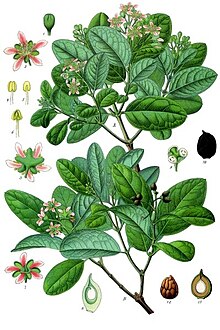bio.wikisort.org - Plant
Peumus boldus, the only species in the genus Peumus, is commonly known as boldo (from the Mapudungun name foḻo). This tree of the family Monimiaceae is natively endemic[1][verification needed] to the central region of Chile, occurring from 33° to 40° southern latitude. Boldo has also been introduced to Europe and North Africa, though it is not often seen outside botanical gardens.
| Boldo | |
|---|---|
 | |
| Scientific classification | |
| Kingdom: | Plantae |
| Clade: | Tracheophytes |
| Clade: | Angiosperms |
| Clade: | Magnoliids |
| Order: | Laurales |
| Family: | Monimiaceae |
| Genus: | Peumus Molina |
| Species: | P. boldus |
| Binomial name | |
| Peumus boldus Molina | |
| Synonyms | |
|
Ruizia fragrans Ruiz & Pav. | |
Due to its common name (boldo), mainly in Latin America, it is usually confused with the Plectranthus ornatus species, known as falso boldo ("fake boldo"), boldo paraguayo or boldo rastrero, which has led to confusion about the uses, properties and toxicity of both species.
Description
Boldo, together with litre, quillay, peumo, bollén and other indigenous plants, is a characteristic component of the sclerophyllous forests endemic to central Chile. Its leaves, which have a strong, woody and slightly bitter flavor and camphor-like aroma, are used for culinary purposes, primarily in Latin America. The leaves are used in a similar manner to bay leaves and also used as a herbal tea, primarily in Chile and Argentina.
Growth
Although not well known, boldo fruits, which appear between December and February, are very tasty, nutritious, small, green, edible spheres. Boldo's assertive flavor comes primarily from the presence of the chemical ascaridole, which is also present in the epazote plant.
Uses
In Brazil, Argentina, Chile, Uruguay, and Paraguay, boldo is mixed with yerba mate or other teas to moderate its flavor. Some families keep a boldo plant at home for this purpose, although boldo teabags are readily available in nearly all supermarkets.
Boldo and plants with similar properties are widely used as mild folk medicine in various South American countries in both urban and rural areas, even among people who do not usually drink herbal teas other than mate beverage. Boldo is officially listed as phytotherapic plant as cholagogue and choleretic, for treatment of mild dyspepsia in Brazilian pharmacopoeia.[2]
Boldo is in the family Monimiaceae, which is closely related to the family Lauraceae (which includes many other plants used for their aromatic leaves, such as cinnamon, cassia, bay leaf, and camphor laurel.)
Boldo leaves have slightly bitter soft flavor and a bit coniferous rough taste when brewed in tea. They are used as a culinary herb to spice many savory dishes with fish, mushrooms, vegetables and as a component in sauces. In some local South American kitchens boldo leaves are also popular to wrap frying fish and meat. Boldo fruits, when dried, are used to make spicy condiments. [3]
Toxicity

In 2009, the European Medicines Agency assessed boldo as follows:
Boldo leaf contains the alkaloid boldine. Boldo leaf also contains 2-4% of volatile oil. Major constituents reported as: ascaridole (16-38%), 1,8-cineole (11-39%) and p-Cymene (9-29%).[4]Mariano, Xavier Maia; Souza, Wanderson Fernando Mello de (2019). "Bioactive volatile fraction of Chilean boldo (Peumus boldus Molina) – an overview". Journal of Essential Oil Research. 31 (6): 474–486. doi:10.1080/10412905.2019.1617797. Retrieved 2021-08-19. Ascaridole is highly toxic, and this raises concerns about the suitability of boldo leaf in traditional herbal medicinal products.
Abortifacient and teratogenic effects in rats were observed with very high doses (800 mg/kg) of a dry ethanolic extract of boldine in the first days of pregnancy, not present at lower doses.[5]
Most investigations have been carried out using boldine.[citation needed]
Limited information is available on herbal preparations of boldo leaf and where studies have been reported, details of the preparations are usually lacking. There are no reported genotoxicity or carcinogenicity studies with herbal preparations of boldo leaf.
Boldo oil should not be used internally or externally. Where boldo leaf is used, the total exposure to ascaridole should be considered from a safety standpoint. The levels of ascaridole in herbal medicinal products should be quantified. In view of the low solubility of ascaridole in water, the use of aqueous extracts including herbal teas could be accepted.[medical citation needed] The use of ethanolic extracts of boldo leaf is not considered acceptable for traditional herbal medicinal products, in view of the potentially higher levels of the toxic ascaridole constituent.[5]
References
- Coop, Paul. "Peumus boldus, Peumus bolod, Boldo -Western-". www.innerpath.com.au. Retrieved 2017-12-11.
- ANVISA (Agência Nacional de Vigilância Sanitária). 2011 Formulario de Fitoterapicos da Farmacopeia Brasileira Archived March 23, 2014, at the Wayback Machine. Brasilia, Governo Federal do Brasil.
- P N Ravindran CABI, Dec 28, 2017 The Encyclopedia of Herbs and Spices
- Mariano, 2019
- Committee on Herbal Medicinal Products (HMPC) (2009). "Assessment Report on Peumus boldus Molina, Folium" (PDF). European Medicines Agency. Doc. Ref.: EMEA/HMPC/591131/2007.
External links
- "Boldo leaves (Peumus boldus Molina)". Gernot Katzer's Spice Pages.
- "Pictures and information of Boldo tree, leaves and flowers".
- "Plantas de la flora de Chile cultivadas en España" [Chilean plants cultivated in Spain] (PDF) (in Spanish). Archived from the original (PDF) on 2009-03-20. Retrieved 2009-06-27.
На других языках
[de] Boldo
Der Boldo (Peumus boldus) ist eine Pflanzenart in der Familie der Monimiengewächse (Monimiaceae).- [en] Boldo
[es] Peumus boldus
El boldo (Peumus boldus) es la única especie del género monotípico Peumus, de la familia de las monimiáceas. Este árbol es endémico de Chile. Sus hojas, de fuerte aroma, se utilizan con propósitos culinarios y medicinales.[fr] Boldo
Peumus boldus[ru] Пеумус
Пеумус больдо, или Болдо (лат. Peumus boldus) — единственный представитель монотипного рода двудольных растений, входящий в семейство Монимиевые (Monimiaceae).Другой контент может иметь иную лицензию. Перед использованием материалов сайта WikiSort.org внимательно изучите правила лицензирования конкретных элементов наполнения сайта.
WikiSort.org - проект по пересортировке и дополнению контента Википедии